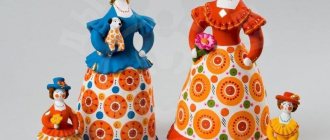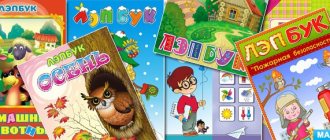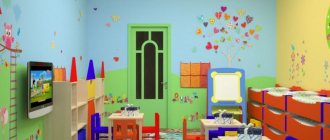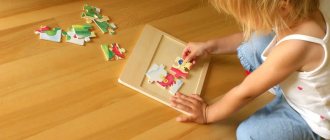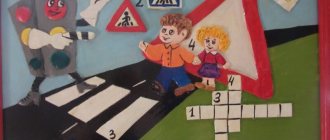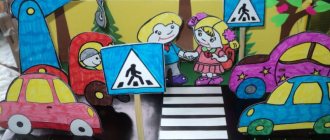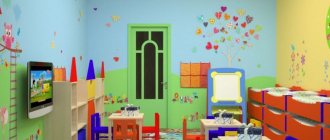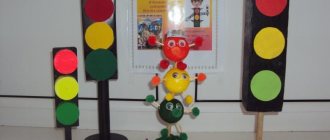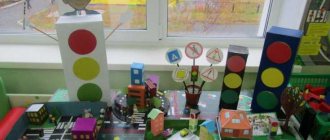As children grow up, many questions arise: “What is this?”, “What is this for?” etc. Adults should pay more attention to a child who is actively developing. In this article we will look at tips on how to easily and quickly teach kids the names of the months of the year.
Children are interested in various topics, including serious ones. When parents encounter something like this, they begin to wonder how to properly answer or explain. For example, they hear the question: “Mom (dad), what is November?” How can you explain to your child in an accessible way that there are 12 months in a year, of which 3 are winter, 3 spring, 3 summer and 3 autumn? That every month has a name, that January is a winter month, and July is a summer month? How to learn the names of all months with your child? And not just find out, but teach them to distinguish them based on specific characteristics?
Where to start learning?
It is necessary to begin the explanation with what a month is in general, how many there are in a year, and why it is customary to divide the year into seasons. Then you need to talk about the generally accepted procedure and begin training by studying the months, starting with the first - January.
Note! A quick way to remember the number of days in a month: clench your fist and look at the bones. The first is January. The month on the bone has 31 days, on the socket - 30.
Tree panel “Seasons” for kindergarten: how to make it yourself
We will look at what a paper panel manufacturing scheme looks like. But there are other variations. A cardboard tree can be covered with a special fabric so that objects with Velcro can be attached to it. This will make it easier for the child to remove the toys and return them. You can use regular fabric. Make small slits in it for some decorations on hooks. The baby will be able to pull them out, play with them, and hang the items in place.
A paper panel is easier to make. Items are mainly laid out on a circle. Some plasticine figures or small toys can be leaned against the trunk. How to make a paper tree game:
- To create a model of the tree, we will use old newspapers. It is enough to draw two identical sides of the tree.
- Cut out shapes from newspaper and attach them to cardboard. Carefully trace with a pencil and cut out cardboard trees along the drawn lines.
- We conditionally divide each fragment in half with a vertical line, draw it from the beginning of the trunk to the top of the head.
- We cut one part along the line from the bottom to half, the other fragment - vice versa. We start cutting from the top, moving also to half.
- We connect the two blanks by inserting them into the slot. We get a tree divided into four parts.
- We make the base in the shape of a circle. It should be proportional to the tree. We fix the figure in the center of the circle. To make the layout durable, you need to apply glue vertically and horizontally along all the joints.
- We dilute the glue with a small amount of water. We glue napkins to all surfaces. The cut area should not be noticeable. To obtain a relief structure of the foliage on the tree, the trunk and the surface around it, we crumple the wet wipes a little during the gluing process.
- We leave the layout to dry for a couple of hours.
- Using paints, paint each quarter in the appropriate color. For autumn we choose yellow, orange, brown tones. Spring – a mixture of white and soft green; you can add snowdrops and tulips. Winter in cold shades of gray, blue, white. We make summer bright, yellow, green, blue.
Sew Vogue Patterns with your own hands: pattern, diagrams and description
Fiesta and siesta: what is the difference, how to distinguish correctly, characteristics
Names of the months in children's pictures
All children love games. It will be more interesting and easier for your child to learn the names of the months if he is shown story-based illustrations or presentations. If parents independently make a presentation about the seasons for their child, it will be even better. An excellent option is to create it together with your child. This way he will remember the names faster.
By finding illustrations about each month and showing them to the child, the parent will be able to fix their names in his memory. To do this, you need to select pictures that demonstrate the life of animals in each season, the type of clothing for each season, etc.

To interest your son (daughter), the presentation must be colorful. You can also display the features of each month. For example, September - leaves fall, the school year begins, and children go to school. In presentations, you can focus on holidays. For example, December - New Year, decorating the Christmas tree and home. Be sure to include the child’s birthday in them - he will definitely know and remember this day.
Winter months
The child needs to be explained that there are 3 winter months - December (ends the year and begins winter), January (begins the year) and February (the harshest month, with blizzards and snowfalls). It is important to choose thematic pictures for the story.
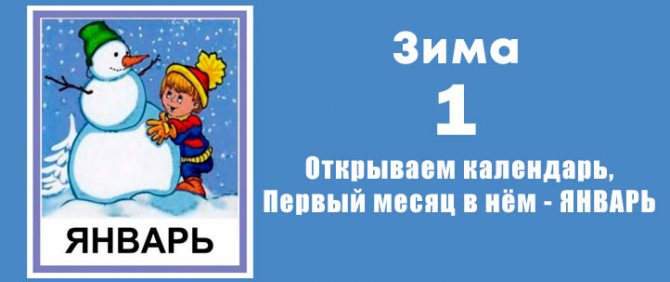
Spring months
The first month of spring is March. This is the period when primroses - snowdrops - appear. The second month is called April. This is a period of changeable weather: sometimes the sun shines, sometimes it rains. The third month – May – is the time when nature begins to clothe the forest. Plot illustrations are also appropriate for the explanation.
Summer months
June is the first month of summer. In ancient times it was called “worm”. This month has the longest day and shortest night of the year - June 22. June is followed by July, the month when linden blossoms intensively. Summer ends - August - time for harvest. In addition to pictures, you can choose riddles that describe each month.

Autumn months
There are also 3 autumn months: September (early autumn), October (golden autumn) and November (late autumn). To describe the season, you can select signs for each month.
Didactic book for preschoolers “Seasons”
Methodological development: didactic book “Seasons”.
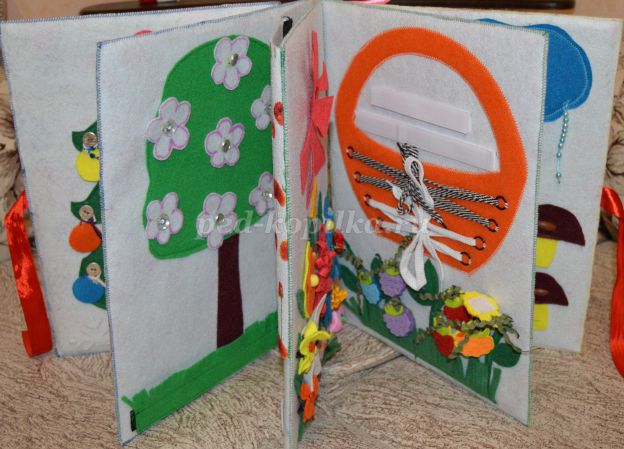
Description: this methodological development is intended for preschool children, it will be of interest to teachers of additional education, educators working in correctional institutions, as well as for educators working in general education preschool institutions, for parents and creative people. Purpose: can be used as a didactic game and for examining a preschooler. Goals: 1. Development of fine motor skills. 2. Formation of ideas about the seasons, their sequence and seasonal changes in nature. 3. Formation of elementary mathematical concepts. Objectives: - expand preschoolers’ knowledge about seasonal changes in nature; - learn to recognize and name the seasons and their sequence from the pages of a book; - develop mathematical concepts: quantity and counting, naming and correlation of colors, orientation in space, discrimination of size; - develop fine motor skills of the hands; - cultivate neatness and interest in activities. Fine motor skills are one of the aspects of the motor sphere, which is directly related to the mastery of objective actions, the development of productive activities, writing, and speech of a child. Physiologists by this expression mean the movement of small muscles of the hands. At the same time, it is important to remember about hand-eye coordination, since the development of small hand movements occurs under the control of vision. Why is it so important to develop fine motor skills in a child’s hands? The fact is that in the human brain the centers that are responsible for speech and finger movements are located very close. By stimulating fine motor skills, we activate the areas responsible for speech. And, in addition, in the future, the child will need these skills to use movements to draw, write, dress, etc. There are various ways to develop fine motor skills of the fingers, for example: 1. Finger gymnastics and finger games. 2. Games with cereals, beads, buttons, small stones. 3. Sand therapy. 4. Cutting with scissors. 5. Applications. 6. Working with paper. Origami. Weaving. 7. Modeling from plasticine, clay and salt dough. 8. Laces. 9. Drawing, coloring. 10. Graphic exercises. 11. Hatching. 12. Bean baths. 13. Mosaic. In addition, to develop fine motor skills, household chores such as rewinding threads can be completed; tying and untying ribbons, laces, knots on a rope; collecting cut pictures; fastening and unfastening buttons, snaps, hooks; screwing and unscrewing lids, jars, vials; sorting cereals (peas, buckwheat, rice) and so on. There are a lot of tasks and exercises aimed at developing fine motor skills. If you wish, especially if you use your imagination and imagination, you can come up with them endlessly. And the main thing here is to take into account the individual characteristics of each child, his age, mood, desire and capabilities. Fingers will not become skillful right away. Games and exercises, finger exercises, carried out systematically from a very early age, help children confidently hold a pencil and pen, braid their hair and lace their shoes independently, build from small parts of a construction set, sculpt from clay and plasticine, etc. Thus, if they As the fingers develop, the child’s speech and thinking will develop.
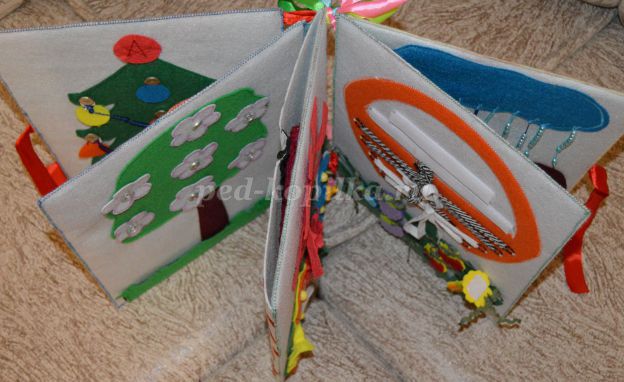
Introducing preschoolers to nature is a means of developing in their minds realistic knowledge about the world around them, based on sensory experience. In a preschool institution, children are introduced to nature and the changes that occur in it at different times of the year. On the basis of acquired knowledge, such qualities as curiosity, the ability to observe, think logically, and have an aesthetic attitude towards all living things are formed. Nature is an inexhaustible source of spiritual enrichment. The great teacher K.D. Ushinsky attached great importance to the conscious acquisition of knowledge and believed that learning gives children complete knowledge only when it is clear, systematic and consistent. Proving the need for visual learning, he developed the theory of visualization. Visibility was understood by K.D. Ushinsky not only as a direct acquaintance of children with nature, but also as the use in lessons of paintings, maps, globes, collections and other aids that help children create a certain image of an object and phenomenon in their minds. Observations of the surrounding reality have a profound impact on the comprehensive development of the child’s personality. The child’s comprehension of what he perceives and the reflection of the results of observation in speech develops the independence of his thoughts, intelligence, criticality of the mind, enriches the preschooler’s vocabulary, improves speech, memory, attention and lays a reliable foundation for the formation of a materialistic worldview. Winter.

Spring.
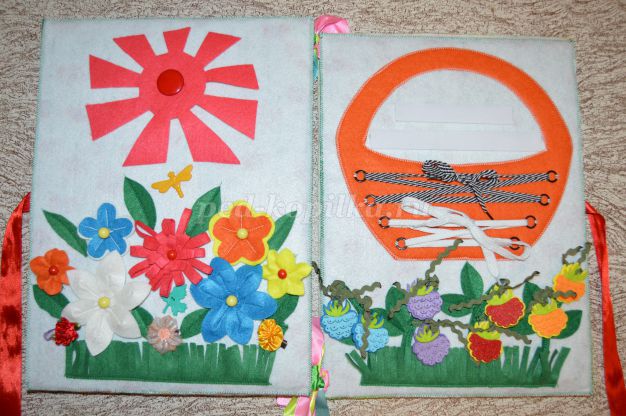
Summer.
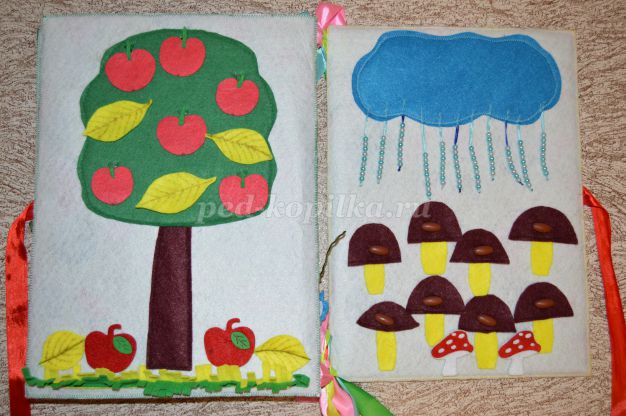
Autumn.
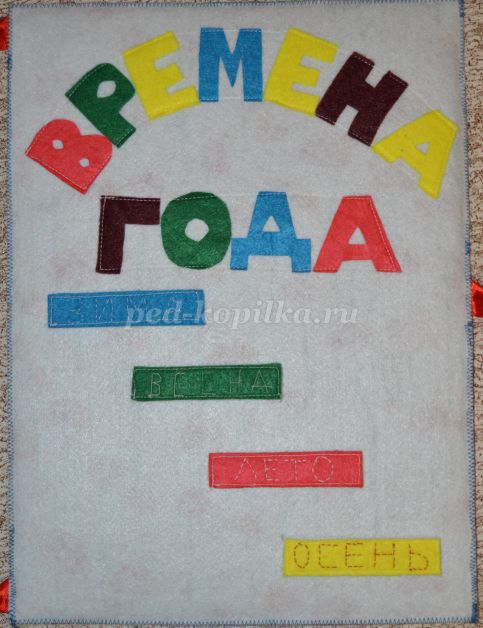
On the title page, the child is asked to attach the seasons with Velcro in the correct sequence from the given one.
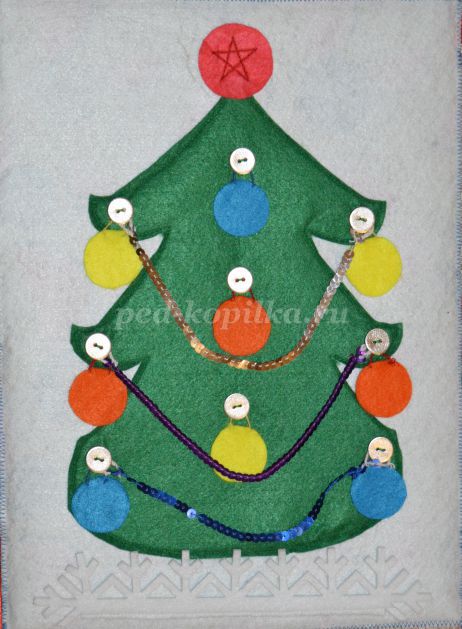
Decorating the Christmas tree. The child can show his creativity. We hang balls and beads using button loops, and a ball with a star on Velcro. The child can be asked to name the colors, compare the length of the beads, count the number of balls on the Christmas tree, and note the spatial arrangement of the toys.
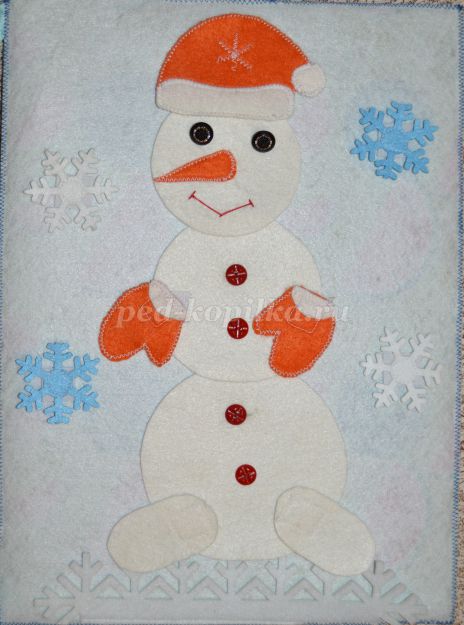
Collecting a snowman. Two parts of the body have buttons, the rest have Velcro. The child can also show the parts of the snowman, compare the sizes of the balls, show where the left and right hand, leg, left and right eyes are, count the number of buttons and snowflakes.

Spring. Green grass grows, which we attach with Velcro. Flowers bloom on the trees, we fasten them with buttons. You can count the number of flowers.
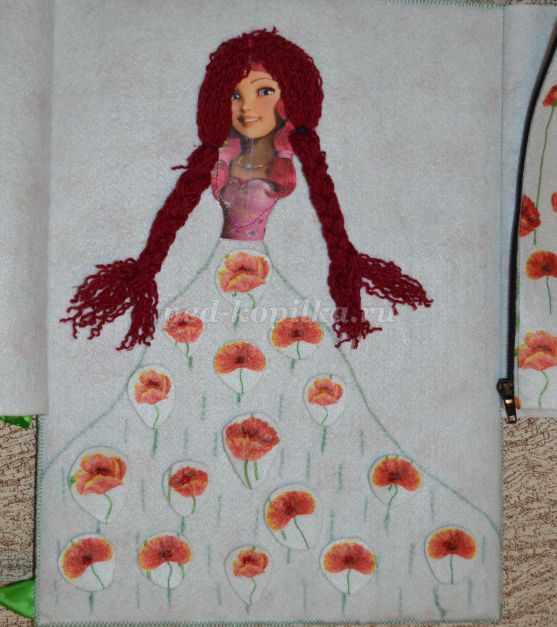
Spring. Flowers are blooming. We attach them using buttons. You can invite your child to count them. We open the window, (unfasten the lock), and braid the girl’s hair.
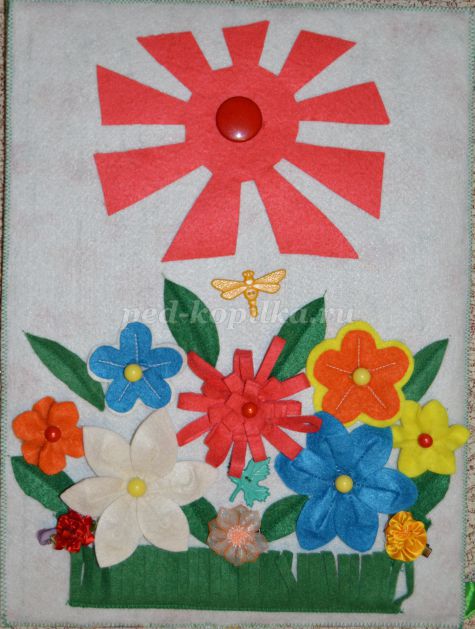
In the summer the sun shines brightly, we fasten it with a button. There are many flowers in summer. We attach them with Velcro, clips, or buttons. You can name colors, compare flowers by size, count. The berries are ripe. We tie them to bushes. You can match them by color by placing the same ones on one bush. Let's count them. We collect the berries in a basket with Velcro. Decorate the basket with lacing.

Autumn. The grass and leaves turn yellow. Leaves are falling. Lots of fruits on the trees. Attach leaves and apples using hooks.

We recommend watching:
Didactic games with sand for children 3-4-5 years old Scenario of entertainment for children of the senior group on the topic: Seasons Scenario of entertainment for children of the senior and preparatory group of pre-school educational institutions A fairy tale about the seasons for children 5-7 years old
Similar articles:
Conversation about the seasons for preschoolers in the senior group
Proverbs and sayings about the seasons for preschoolers
Didactic games about the seasons in kindergarten for older children
Poems about the seasons for preschoolers with pictures
Didactic game “Collect a caterpillar” for children 5-6-7 years old
How to learn the names of the months from books
Experts recommend buying children's educational and developmental books about the seasons and months. Such manuals explain to children the features of nature and the signs of the months in an accessible way. Some editions of such books contain tasks for consolidating material that will strengthen the memory of the topic studied.
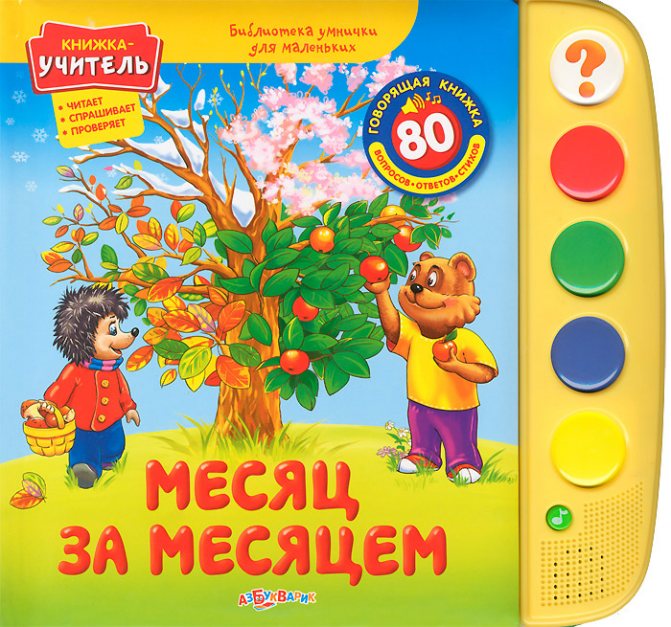
Poems can help you learn the names of the months. After studying them, your memory will improve. You need to buy special literature with poems, fairy tales and stories about the 12 months. The book “365 Bedtime Stories” has proven itself to be excellent. The pictures in it are sorted by season, and each page corresponds to one calendar day. The book contains poems and stories that fully explore the theme of the 12 months. It's great for teaching with kids. No less useful is the encyclopedia “Seasons” with answers to many questions.
We decorate a kindergarten with our own hands: decor of different rooms
Having made New Year's toys with your own hands for kindergarten, you should think about where they will find their place. It’s good when the decoration plan is thought out in advance. In this case, the entire registration process will be friendly and short.
The staircases, locker room, foyer, music room and groups are subject to decoration.
Stairs between floors and corridors
The staircase is decorated in two ways: the decor is hung on the railings or on the walls. If you want to combine both methods, this will be the best solution.
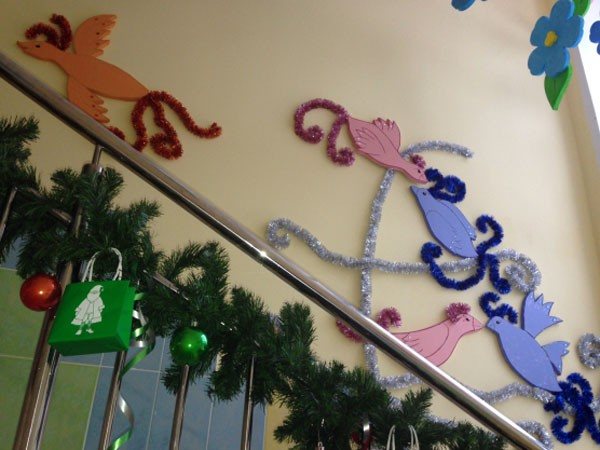
It is advisable to leave the handrail free for convenience; this is a matter of safe descent and ascent of children
Garlands and various thematic compositions are hung on the walls.

Textiles perform excellent decorative functions

Installations are made from different materials. For example, this could be a scene from a New Year's fairy tale

Arches are made from tinsel and wire
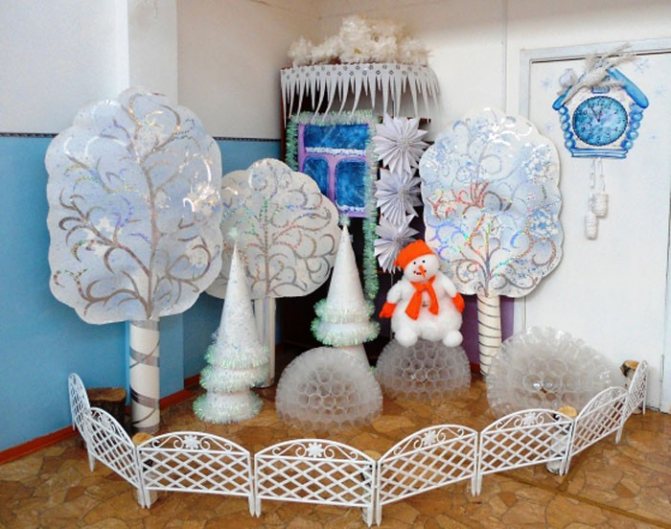
The thematic installation is created from ordinary materials: paper, tracing paper, oracal, textiles and cardboard.
How to creatively and fabulously decorate a kindergarten group
For such an activity as decorating a group in a kindergarten, faithful teachers always take on it. And it would be good to involve parents in resolving this important issue - who else knows the preferences of their own children better?
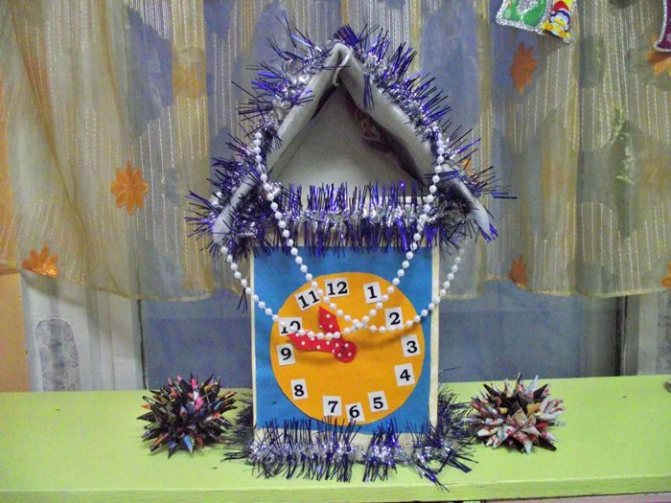
Handicrafts can take more than one day to prepare, so their production must be completed by the time of design work
We decorate the kindergarten group with our own hands: coniferous compositions bring the holiday even closer. Such a beautiful vase with a New Year's bouquet can stand on the teacher's table
Textile fairy tales on windows and doors
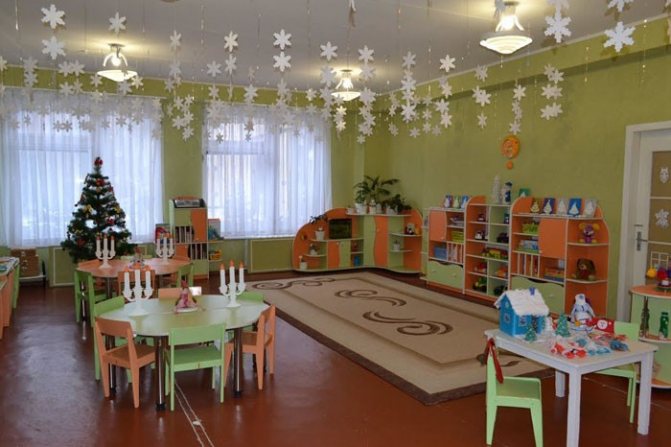
Good old snowflakes: turning a large space into a magical snowfall
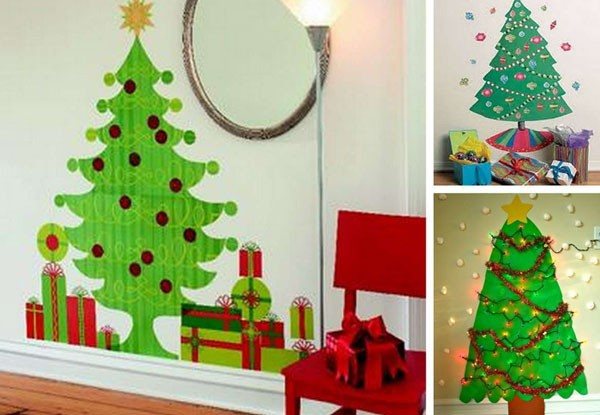
Wall trees are both safe and original
Decorating the kindergarten music room for the New Year
The most important thing is to remember that just as we decorated the hall in the kindergarten, that’s how we will hold the New Year’s party there. We put all our energy and creative ideas into decorating the music room.
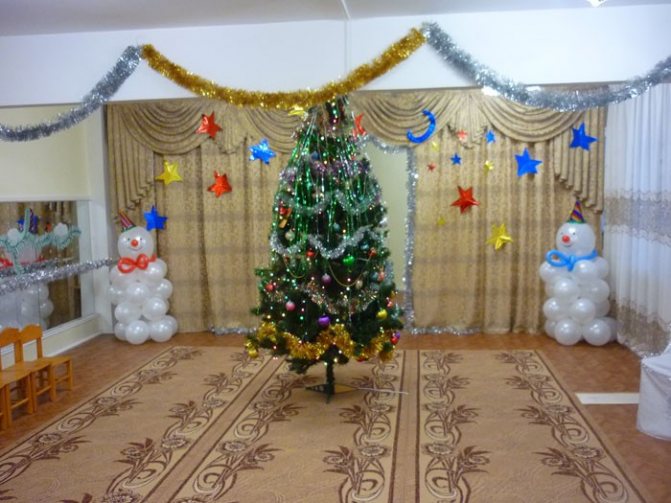
Balloon decor is inexpensive and impressive. Balloon figures can easily decorate a large area

2D figures made of textiles and paper are used as a thematic background. In the background they make snowmen, a snow-covered village or several Christmas trees
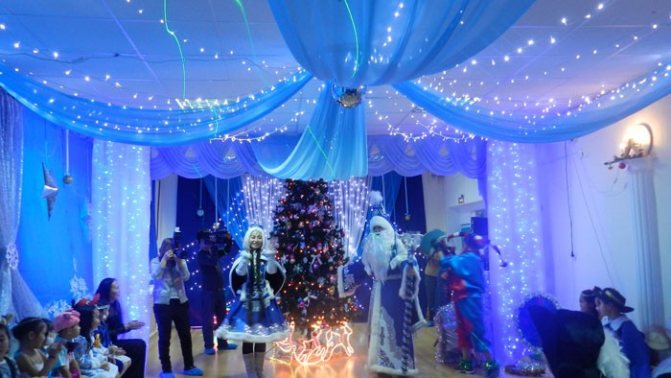
Long pieces of transparent fabric are used to create a real New Year's tent, which can be compared to the hall of the Snow Queen's castle
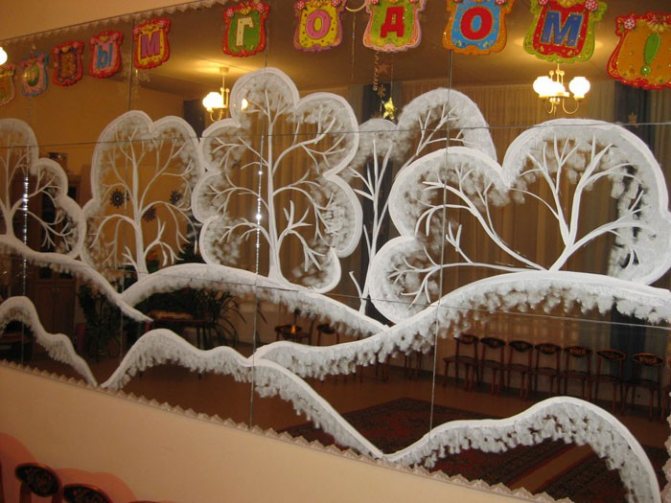
If there is a corner with mirrors in the hall, they are also decorated. Coloring is done using a brush with stiff bristles, toothpaste and water.
Learn the names of the months by playing
Theatrical scenes will help your child remember the names of the months and seasons. The child can be both a participant and a spectator. You can also pick up riddles or come up with them yourself. For example, draw people wearing clothes according to the seasons and ask the child to name what time of year they wear such clothes. Drawing pictures with your child that correspond to each season will also be useful.
A great way to learn and remember the months is a didactic game. They are developed specifically for preschool children. They also demonstrate relationships with the environment, develop memory and logic.
Information that is interesting to children is remembered quickly. They always want to learn a lot of new things, so they ask adults questions and explore the world. Children are good communicators who know how to listen. Studying the months is a fun topic for a child. He will be happy to study it with mom or dad.
Don't forget about decorating the kindergarten yard for the New Year
Even approaching the gate of a children's educational institution, the child will experience a lot of positive emotions if there is a festive atmosphere outside. It is created by the hands of the kindergarten staff, and it is worth giving them credit for such work. If parents take part in preparing a kindergarten for the New Year, then such an institution can be proud of its students and their families.
In regions with good snow cover, snow will be an excellent decorative material. These are fortresses, figures, snowmen - they can be painted in different colors or decorated with pine and spruce branches with toys.
When sculpting, you should use a spray bottle of water - on the next frosty day, all sculptures will be covered with a thin layer of ice and will become very durable
To decorate snow figures, any available material is used, including bottle caps.
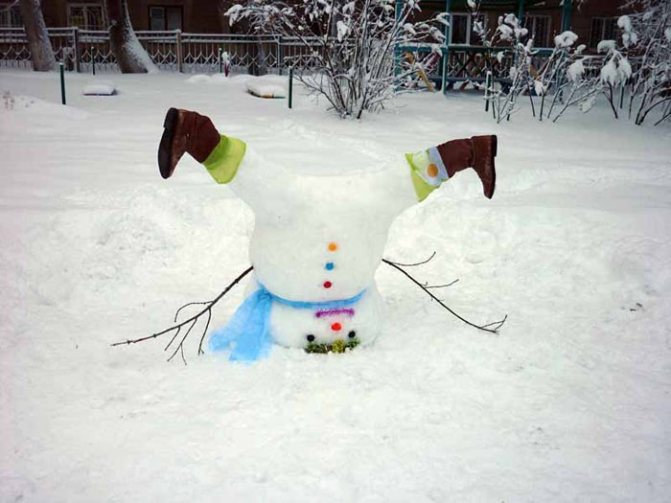
Funny snowmen will delight even moms and dads rushing to work
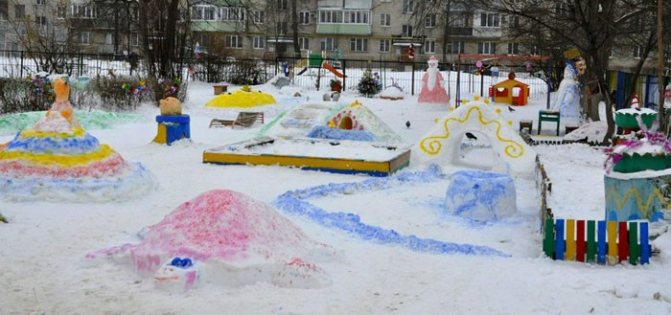
Within a few days, the snow-covered yard turns into a fairy-tale town
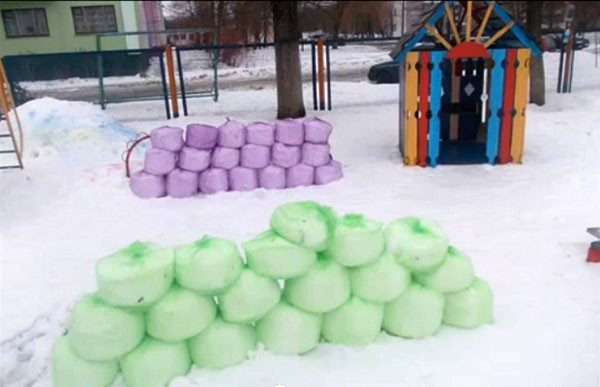
Colored garbage bags will serve as the basis for a bright fort.
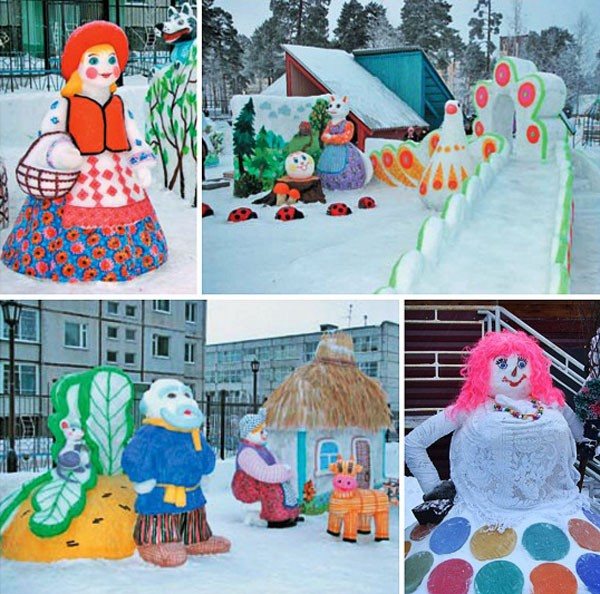
They paint the snow with gouache diluted in water. The easiest way to spray sculptures with paint is from a spray bottle.
If there is little or no snow, but there is frost, then pour colored water into gloves and balls of different shapes. Once the ice forms, the shell of the balls is broken open to create a cool yard decoration.
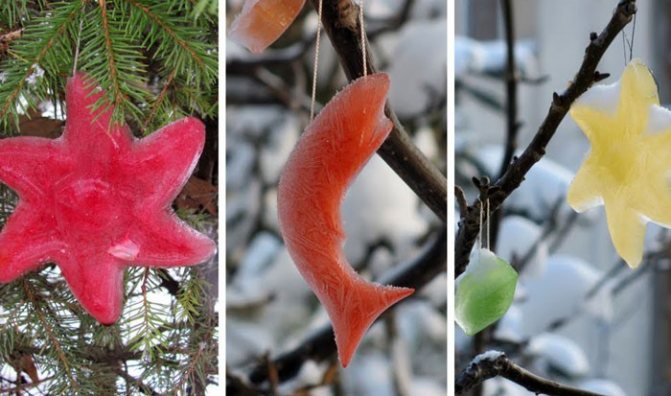
If you use molds and don’t forget to insert a suspension into the freezing water, you can easily get a lot of bright ice toys, like the photon street tree in the kindergarten yard
How can you use them?
Pictures on the theme “Change of seasons: spring, summer, autumn, winter” and a didactic game for children are best suited. This way the child will better remember the material being studied. First, the child should be explained what natural phenomena are characteristic of each time of the year. Only then can he be shown all kinds of pictures for children with images of different seasons. When the baby looks at them carefully, let him name all the seasons that the didactic game offers. This way, your child will not only visually remember new information, but will also be able to consolidate it well.
At home, you can come up with another option for studying the change of seasons for children.
For example, such a didactic game could be created. To do this, make your own card from white cardboard and draw on it in the upper part flying birds, a blooming snowdrop, a strawberry bush and a sleeping bear. From each drawing, draw paths in the form of a labyrinth, label the corresponding seasons of the year below. Ask your child to walk along the paths of the labyrinth and say at what time of year birds fly to warm countries, when snowdrops bloom, when strawberries ripen in the forest, and at what time of year the bear sleeps. Start such activities with your child only when he shows interest in it. The following didactic game may be applicable in kindergarten. The teacher gives each child 4 children's cards with images of certain objects. Gives a few minutes to consider them. Then he asks to name whether there is an extra item among them that does not relate to a certain time of year. For example, a snowman is an unnecessary item, because it can only be made or encountered in winter. The one who names everything correctly wins.
This didactic game for children “Change of seasons: spring, summer, autumn, winter” is well suited. The teacher invites the children to choose the name of the season of the year, for example, spring or winter. When everyone has made a choice, they are shown one by one fragments of pictures with different seasons. The one to whom this fragment suits takes it for himself. Whoever completes the task first will be the winner. Here I have collected free pictures for children “Change of Seasons”, as well as posters, all kinds of cards about the seasons, games and much more. All materials can be downloaded for free. Click on the pictures below to download and print.
The didactic game “Change of seasons: winter, spring, summer, autumn” for children develops creative abilities and helps to increase the level of erudition. It will interest your child in learning about the seasons, nature and its features. Play is the main method of teaching children. Only she can make them sensitive, inquisitive and interesting people.
